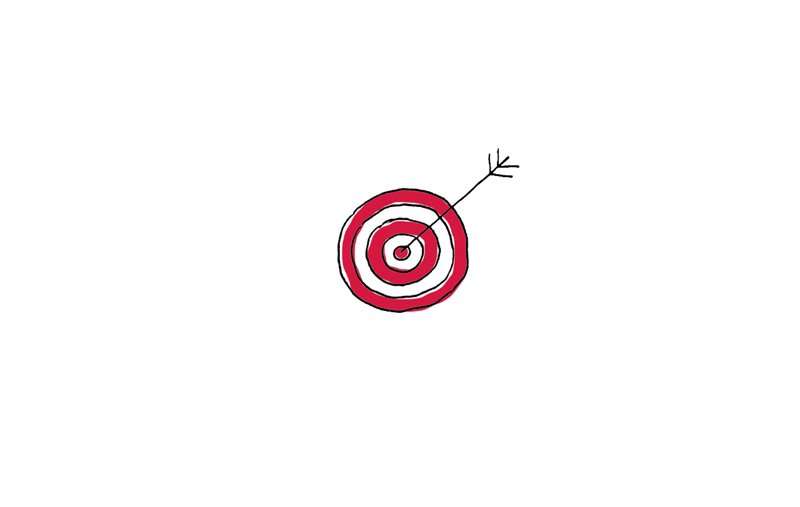How to Stay Focused on Your Goals No Matter What (and Finally Achieve Them)
Support Journal Smarter by buying a pdf version of this article (including the layout of the weekly spread).
In theory, achieving goals is quite a simple process:
- Set a goal and identify action(s) to take.
- Take identified action(s) and achieve the goal.
However, when it comes to practice, it’s obviously more complicated.
Allow me to illustrate: imagine that you want to spend a month bicycle touring in Europe next summer.
You grab a piece of paper and write down some key things you need to do. It might look like this:
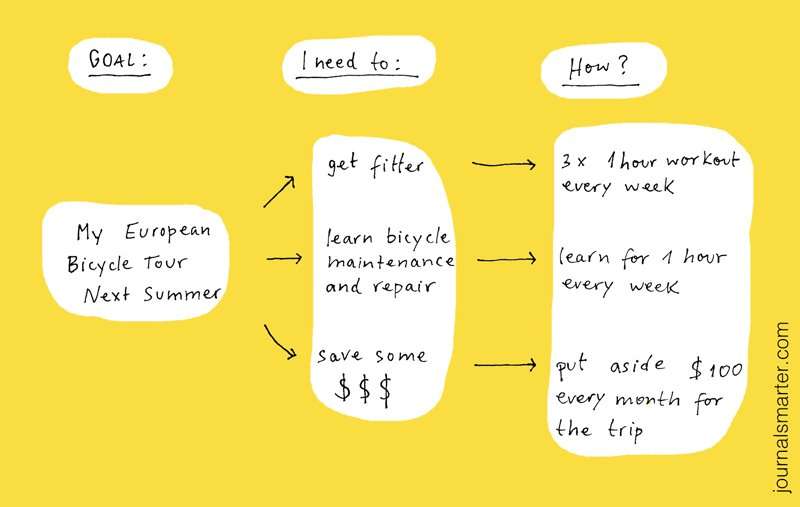
After one hour of brainstorming, you have a clear goal, with three tangible actions to take. Easy peasy, right?
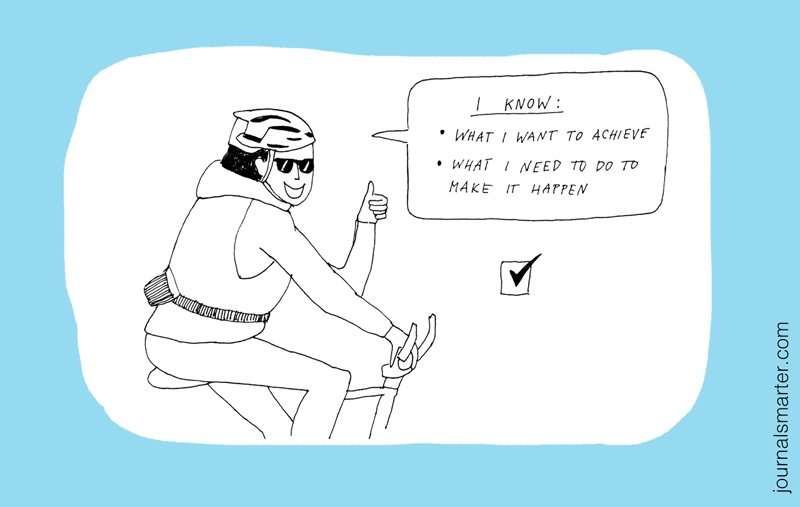
The thing is, goals don’t exist in a vacuum. Therefore, real life always gets in the way of our plans.
Unable to do everything all at once, we tend to prioritize easy (but irrelevant) tasks, having fun, or solving unrelated problems. We are as busy as ever, yet we keep postponing the actions that really matter. As time passes, we don’t even remember why our plan was important in the first place—or even worse, what our goal was.
I call this the distraction trap: the looming hole between a plan and the act of making it happen.
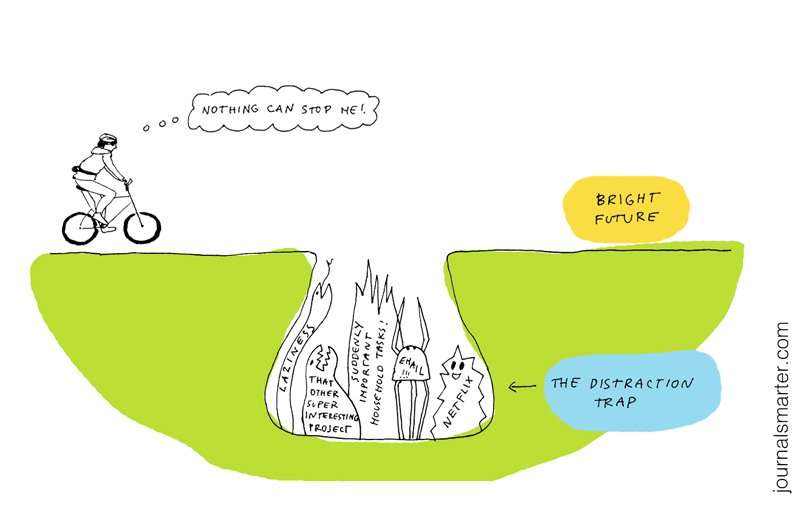 The distraction trap is well camouflaged, making it very hard to spot. Poor cyclist stands no chance…
The distraction trap is well camouflaged, making it very hard to spot. Poor cyclist stands no chance…
So, how can we jump over the distraction trap and progress towards our goals?
It’s simple: all you need is a bridge.
In other words, in order to achieve your goals, you need to see the link between the “why” and “how”; you need a constant, clear overview of how your “micro” tasks contribute to your “macro” goals, so that you can engage in meaningful action every day without getting derailed.
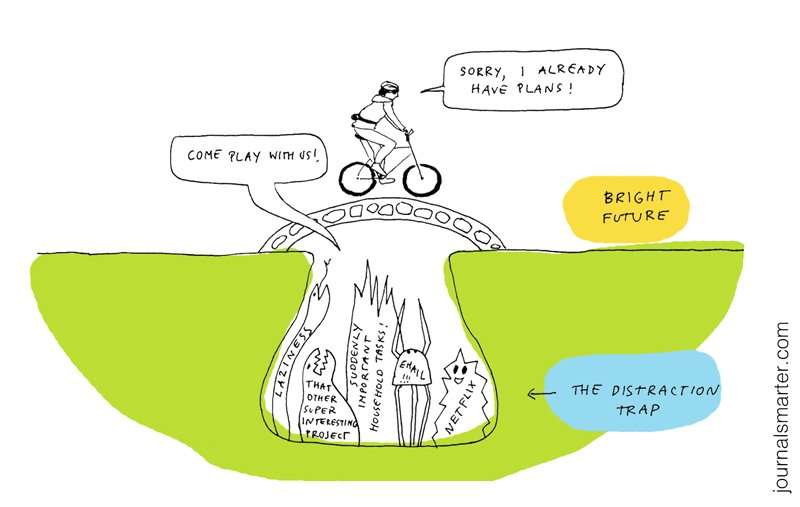 Keep it up for long enough, and you’re bound to reach your goal!
Keep it up for long enough, and you’re bound to reach your goal!
In this article, I will show you how to build this bridge.
All you’ll need is a pen, paper, less than 0.94% of your weekly time (60min or less per week + 5 min per day), and a simple spread divided into two sections: Goal Filter and Action Plan.
 Together, your goals and actions provide a crystal clear overview of what you are doing, why you are doing it, and what’s your progress.
Together, your goals and actions provide a crystal clear overview of what you are doing, why you are doing it, and what’s your progress.
Here’s how it works.
1. Goal Filter: Stick To What Matters Most
Here’s a secret:
You make your goals happen today, not in the future.
That’s why, whatever your goal might be, start with breaking it down into simple actions you can actually take every day (especially on that crappy day when you don’t feel like doing anything at all).
By transforming your goal into daily actions you can ensure that:
- You understand how your “micro” actions contribute to your goals;
- You make constant progress;
- You filter out everything that is trying to derail you.
That’s where your Goal Filter comes into play.
 Note: I highly recommend playing around with different layouts to find the one that works best for you. It might take some time but it will be worth it.
Note: I highly recommend playing around with different layouts to find the one that works best for you. It might take some time but it will be worth it.
Here’s how to use it.
- Define your goal: what do I want to achieve?
- Set your milestone: what is the first thing that I need to make happen to progress towards my goal?
- Identify High Impact Actions: what are (up to three) actions/habits I can engage in this week that will ensure the most effective progress towards my milestone?
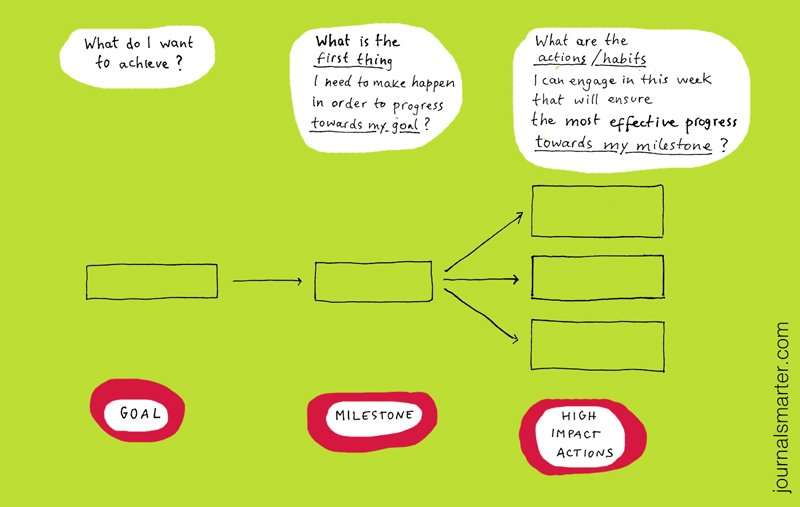 It might be useful to keep those questions handy.
It might be useful to keep those questions handy.
Let’s look at some examples.
Example 1
Q: What do I want to achieve?
A: Be super fit and healthy.
Q: What is the first thing that I need to make happen to progress towards my goal?
A: Find a diet that works best for my body.
Q: What are (up to three) actions/habits I can engage in this week that will ensure the most effective progress towards my milestone?
A: Watch one video every day exploring different diets; go vegetarian for a week; track the performance of my body (energy level, focus and quality of sleep).
Example 2
Q: What do I want to achieve?
A: 10x my income
Q: What is the first thing that I need to make happen to progress towards my goal?
A: Become debt-free.
Q: What are (up to three) actions/habits I can engage in this week that will ensure the most effective progress towards my milestone?
A: List all of my subscriptions and cut the unnecessary ones; spend at least $1 less every day and redirect the money towards paying back my debt; research a better credit card deal.
Example 3
Q: What do I want to achieve?
A: Finish my thesis.
Q: What is the first thing that I need to make happen to progress towards my goal?
A: Outline the whole thesis.
Q: What are (up to three) actions/habits I can engage in this week that will ensure the most effective progress towards my milestone?
A: Create a mind-map for the whole thesis; compile research materials; outline the first two chapters.
How would this look like for you?
Once you are clear on your goal, milestone, and High Impact Actions, draw your Goal Filter on the left side of your weekly spread, so you can look at it every day.
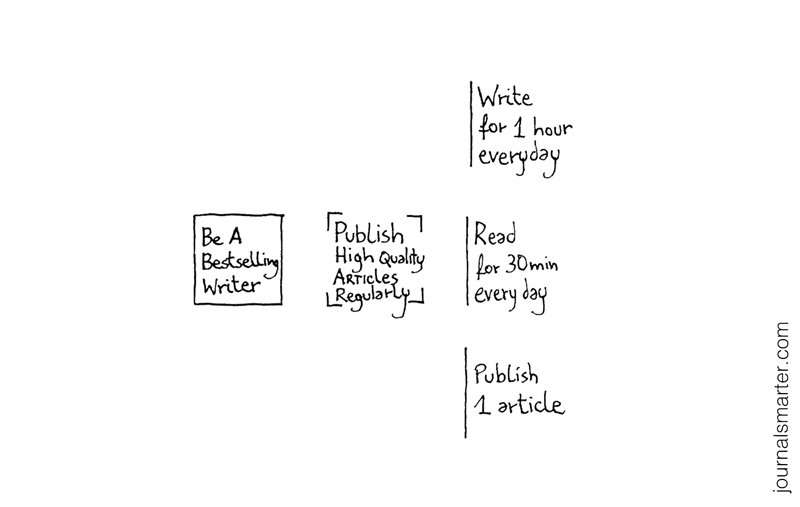
One last thing:
Make it as easy as possible. I highly recommend starting with one goal and a maximum of two High Impact Actions. You can always add more later, but the most important thing is to actually do it.
Remember:
By taking action today you are already becoming who you want to be in the future.
2. Action Plan: Make It Easy
When you know where you’re going, you just need to walk the path.
This is where things get hard, but don’t despair. In order to make it easy for yourself, you simply need to remove points of resistance.
And one of the biggest ones is the energy spent on making choices.
Yep, that’s true—there’s research proving that there is a limited amount of “choosing power” available to you every day. In order to preserve it for making important decisions, you should avoid wasting it on thinking what to do next. If you want to learn more about removing resistance points and optimizing yourself for success, I’d highly recommend reading Atomic Habits by James Clear and this article by Benjamin Hardy..
In other words, the most effective way to become unstoppable is to know exactly how your tomorrow will look like.
That’s where your Action Plan comes into play.
Here’s how to use it:
 Each box represents one day of the week.
Each box represents one day of the week.
At the end of each week, take some time to reflect and plan your next seven days.
You’ll notice straight away that the space dedicated to each day is very small. This is not a mistake: by restricting available space, you’re forced to focus on the critical tasks only and avoid overcommitment. As Tim Ferris recommends in his bestselling book 4h Work Week:
“There should never be more than two mission-critical items to complete each day. Never. It just isn’t necessary if they’re actually high-impact.” — Tim Ferris
Before planning your High Impact Actions, write down your prearranged commitments, such as important meetings Every week, I review upcoming events and appointments and run them through my Goal Filter. If they are aligned with it, I commit them to my Action Plan; if they are not, I cancel them. You won’t believe how many events I thought I needed/wanted to attend, only to realize the last minute that they were distractions not bringing me any closer towards my goals., in their appropriate space. This will give you an overview of the total time available this week.
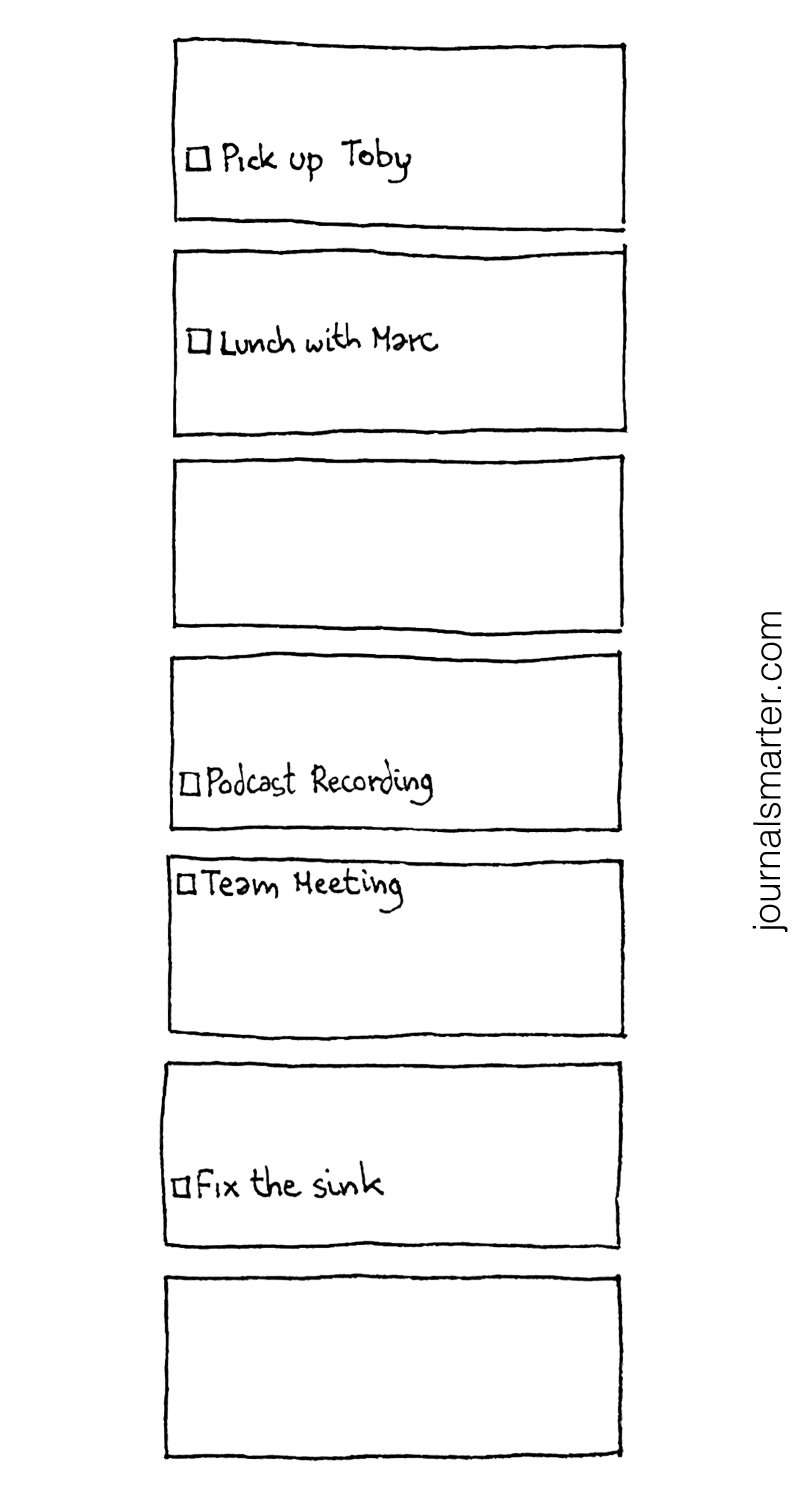 You can see your availability at a glance!
You can see your availability at a glance!
The next step is to make time for your High Impact Actions.
You’ll be taking advantage of timeboxing—a practice of migrating to-do lists into calendars with the intention of blocking the necessary time for them If you want to learn more about timeboxing, here’s a great article by Marc Zeo-Sanders. Simply commit them into your Action Plan for the entire week.
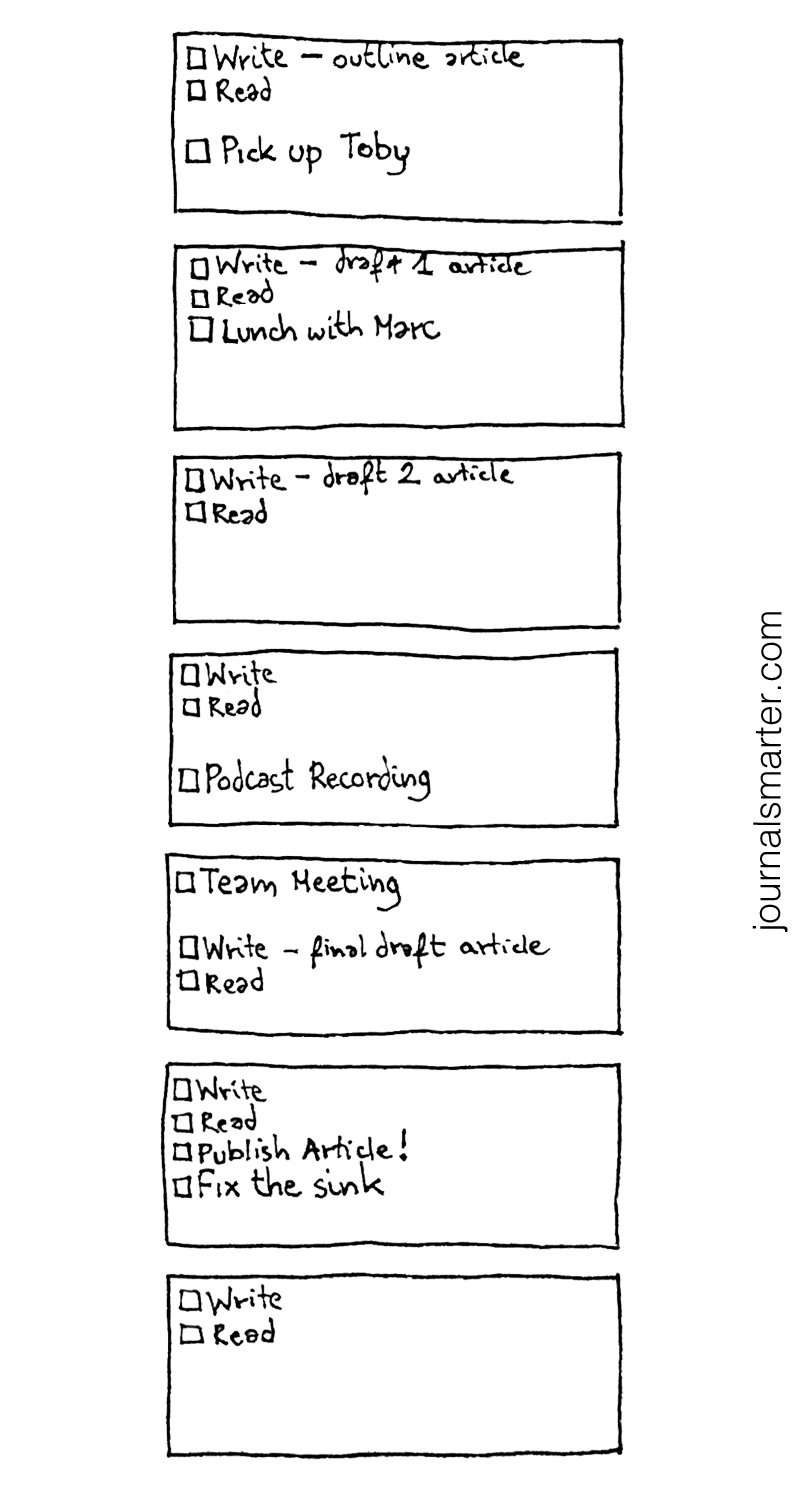 After timeboxing the High Impact Actions there’s not that much time left.[/caption]
After timeboxing the High Impact Actions there’s not that much time left.[/caption]
Then, every day (including your weekly planning session), take an extra five minutes to plan your next day in detail.
Your High Impact Actions and important prearranged commitments are already there, but you might want to add other non-critical items. Look at your Goal Filter and choose wisely (Pareto Analysis might come in handy). You might want to ask yourself: “Will doing this bring me closer towards my milestone?”
Rule of thumb: if it doesn’t fit, then you’re overcommitting. Instead of failing to do too much, succeed in doing too little and reinvest the free time into meaningful action or quality rest.
When you decide on the tasks for the following day, write them down in chronological order, so you don’t need to think about where to start. You just removed one of the biggest points of resistance!
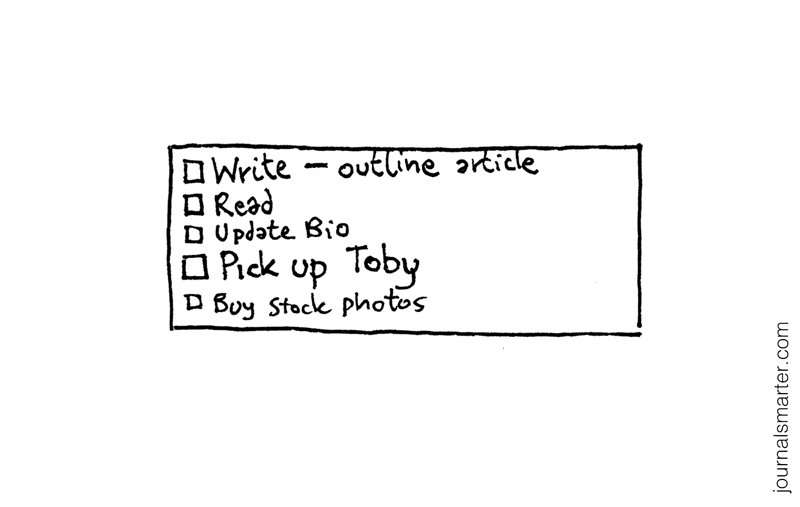
Note: I never plan non-critical items more than one day in advance, so I can remain flexible and keep my options free.
That’s it. Your Action Plan is ready.
That All Sounds Great, But How To Actually Do It?
“Success is not a goal to reach or a finish line to cross. It is a system to improve, an endless process to refine.” – James Clear
Here’s a hard truth:
Planning is a prerequisite to success, but without execution it’s fruitless. That’s why this system aims at making it as confusion-free as possible.
Your actions are waiting for you in chronological order. More importantly, they are not just any actions: they are t_he most effective things you can do_ to achieve your goal. And if you forgot what you’re working towards… Well, your goal is right there, next to your actions.
Every day, look at your spread, engage in the next action, and mark things complete as you fly through the day.
Whenever you feel off-track or confused, or notice that you’re procrastinating, simply look at your spread and ask yourself:
Am I engaging in my High Impact Actions?
If you are, then great—you’re right on track. If not, then look at your High Impact Actions and work on one of them instead.
It doesn’t get simpler than this.
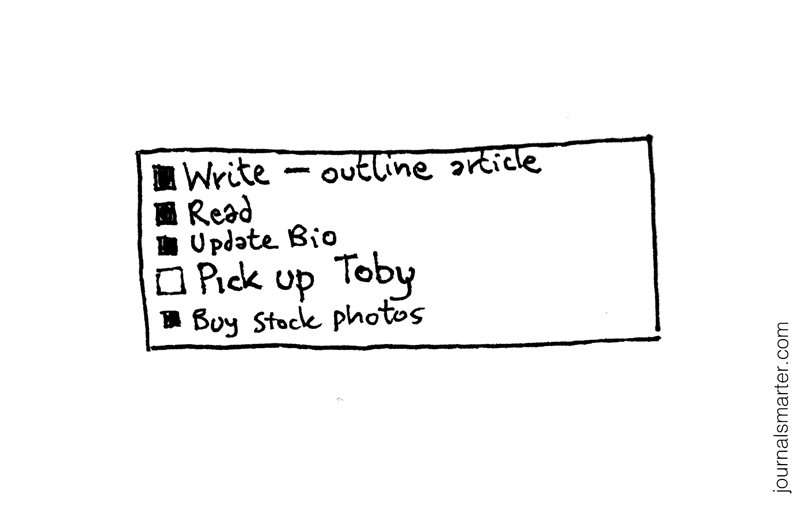 Only one thing left! Let’s do it!
Only one thing left! Let’s do it!
Before you start celebrating, there are two last things to do.
1. Daily Review & Planning (5 minutes)
At the end of each day, look at your spread and ask yourself:
How can I make my High Impact Actions inevitable to happen tomorrow?
When you know your answer, plan your following day and start again.
2. Weekly Review & Planning (30-60 minutes)
At the end of every week, take a moment to reflect upon your progress. Adjust your goals and High Impact Actions as necessary, then plan your next week and repeat the entire process:
- Define/review your goal, milestone and High Impact Actions;
- Plan your week;
- Make it happen;
- Review, optimize and repeat.
 You can print this image or get a pdf template at the end of the article.
You can print this image or get a pdf template at the end of the article.
I need to be honest with you.
The process presented in this article is an excellent place to start, but it’s not going to make your challenges magically disappear.
There will be days when you feel like crap. You will get distracted. You will lose motivation and question whether you can ever become the person you would like to be. That’s all part of the process.
The good news is that every single time you bring your awareness back to your goals and High Impact Actions, you are taking another step towards your destination. That’s what this weekly spread is for.
Step by step, breath by breath, you will inevitably get there. And when you do, you will smile to yourself, knowing that there is no magic trick to it—you simply walked the path you have chosen.
It’s totally within your power.
Note: If this is useful, you can help JournalSmarter to exist and buy a pdf version of this article including the layout of the weekly spread. No pressure, though. We love you anyway!
Resources
- The method explained in this article can be integrated with the Infinity Squares. Here’s one way to do it: How to Finally Stop Procrastinating With 1 Simple Journaling Methodology.
- If you are new to goal-setting, here’s an excellent article by Rafael Sarandeeses, which helped me tremendously with designing my own system.
- Procrastination is a scary monster. And this is a super-helpful article on how to deal with it, written by Tim Urban.
